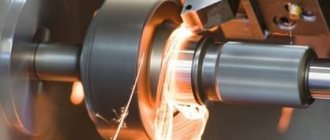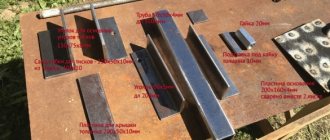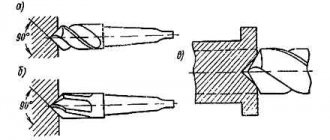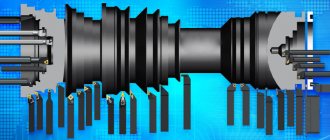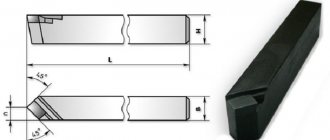Lathe
Special equipment for processing wood on a lathe is not cheap. To learn turning, a regular drill attachment will also work. What you shouldn’t skimp on is chisels: cheap and low-quality ones usually become dull after the first experiments with hard wood and no longer cut, but tear the wood.
In order for a product to be accurately processed, it must be properly mounted on the machine. For this purpose, special devices of various shapes and sizes are provided on lathes.
Rough processing of wood is carried out at low speeds, finishing and grinding are performed at higher speeds.
Safety precautions
Turning work requires, among other things, training in lathe safety. The first thing that training begins with is the basic concepts of safety precautions; if they are violated, there is a risk of injury to hands and eyes, and in the saddest cases, neglect of safety precautions can result in death.
- overalls must fit snugly to the body; work must be done in safety glasses and work boots with a metal toe cap;
- there should be no foreign objects in the work area, and the workplace should not be cluttered;
- it is necessary to control the reliable fastening of the workpiece in the clamp;
- It is strictly forbidden to pass anything over a working machine, remove chips with your hands and not with a sweeper, stop the chuck while moving, or move away from a working machine;
- after completing the working day, the turner tidies up the workplace, clean it of metal waste and scraps, wipe it and put the tools and equipment in tool cabinets;
- The technician constantly monitors the level of the cutting fluid, the integrity of the electrical wiring, and the absence of damage to the housing.
Safety precautions in turning production
Turning is an interesting, but complex activity that requires constant training, which is a fun activity to master. The attractiveness of this skill is not only in obtaining a profession or auxiliary use, but also in an original hobby. Turning original crafts on a machine is no less enjoyable than collecting stamps or knitting, and original steel souvenirs can truly surprise your friends. And the value of real turning professionals in the labor market will ensure permanent employment.
Turning tools
Tools made of high-quality steel are considered good for turning work. They are expensive, but will last longer than regular chisels. To save money, you can buy cutters and handles for them separately. The standard length of the handle is about 25 cm, but you can use longer ones - 30 and 40 cm. With such a handle it is easier to guide the tool.
To turn wood on a lathe, the following types of cutting tools are used:
- a semicircular chisel is suitable for rough processing; it is used to give the workpiece a cylindrical shape;
- With a semicircular narrow and spindle-shaped chisel, thin grooves are cut across the fibers;
- the chisel can be of an oval profile or with a rectangular cut and different sharpening angles: it is used for finishing wood turning;
- Wedge-shaped and acute-angled cutters are used when it is necessary to make small indentations in the workpiece. They also separate the finished part from the edge of the workpiece. Using flat cutters, wide cuts are made parallel to the vertical axis of the workpiece;
- Experienced craftsmen also have a set of scrapers with different cutting edges: pointed, straight, rounded, or a universal scraper with interchangeable cutting attachments.
Workpieces for turning
For turning, do not use soft layered wood, since it will split into layers and it will not be possible to obtain a smooth surface when turning.
Most hardwoods are suitable for turning on a lathe. Birch, beech, maple and ash are distinguished by uniform, light-colored wood. Walnut, mahogany and teak are characterized by dark wood. Cherry, plum, elm, and oak have attractive wood textures.
Master class on turning
Rule number one from our forum member dgusepe: when starting to manufacture a product, first of all you need to take care of safety precautions. Fasten your clothes to prevent them from getting caught and twisted when the machine rotates; be sure to wear safety glasses or a mask to prevent chips from getting into your eyes.
Read also: Welding inverter Tolyana avt200 diagram
Then carefully sharpen the cutters and you are ready to start. Start with simpler products, with a puree masher. Mark the center at the ends of the workpiece. Then clamp it between the headstock and tailstock. Adjust the tool rest to be 5mm away from the workpiece. Turn the workpiece by hand. Check that when rotating, it does not touch the rest.
Turn on the machine and rough the workpiece with a through cutter. Press the cutter against the tool rest with your hand and smoothly move from right to left. Mark the grooves. Use a small semicircular cutter to select two notches. Make a handle between the notches.
At first the cutter may slip back, but gradually you will get used to it. For a flat cutter, the grip should be the same. Sharpen with your heel itself. The cutter is wrapped in the hand and sharpens to the right and left.
Turn the cutter over when pruning. When sharpening a handle, the sequence should be as follows: cut with the “toe”, and trim with the “heel”.
Separate the workpiece from the edge and sand it with sandpaper. No special grinding is required, since this method of turning produces a smooth surface.
Finally, burn the strips with wire.
Based on materials from participants of the “House and Dacha” forum
Everyone who has connected their life with woodworking, no matter whether it is a professional or an amateur, one day encounters a difficulty. Which tree is best to choose for certain tasks.
Today we will talk about such a process as turning wood on a lathe, or rather, what kind of wood is best to choose for this work.
It has long been no secret that hard wood is used for wood turning. This is due to the fact that such wood is easily sanded and polished during processing. It has a complex and beautiful texture, does not require coloring, as it has a unique pattern by nature.
The best wood for the beauty of the internal design is the wood of such trees as: walnut, apple, pear, plum, cherry, alich, oak.
They can make beautiful decorative elements, wooden dishes, exquisite expensive furniture, souvenirs, and candlesticks. That is, those things that surround us every day in everyday life.
Of the species listed above, walnut is especially beautiful. The dishes made from it turn out incredibly beautiful, and the coffee color of its texture seems very edible.
Less beautiful in design, but not nearly inferior in practical use, are the following trees: Beech, hornbeam, ash, maple, birch, alder.
These species are better suited for furniture, parquet, fittings, door handles, etc. Beech and hornbeam are especially suitable for parquet.
Of course, this is not the entire list of trees suitable for turning, but in the CIS countries these are the most accessible materials.
Creating wooden cylindrical products is impossible without a hand tool - a chisel for a lathe. It is from under its blade that the unnecessary amount of material is removed and the workpiece acquires an artistic decoration.
Turning chisels can be bought ready-made, but such kits are very expensive, especially high-quality ones. Cutters for wood processing are easy to make yourself, which will be discussed further.
Read also: What can be done with an 18650 battery
Buy wisely!
We value the trust of our customers, so we are always ready to find an individual approach to each customer. We will send your order to absolutely any corner of the country, we will offer the most convenient method of payment for the goods for everyone. Our catalog is regularly updated with new models of blanks made of various metals.
If you do not find the required blanks among the catalog assortment, you can always purchase blanks from us to order in strict accordance with the parameters you specified. At the same time, we cooperate exclusively with reliable, time-tested suppliers of metal blanks, so you can rest assured of the high quality of the products presented in the catalogue. We sell metal blanks both wholesale and retail, offering to buy them individually. Contact us, and we will definitely offer everyone the most favorable conditions for purchasing metal blanks in absolutely any volume!
What types of chisels are there?
For professional processing of a wooden workpiece on a lathe, various working tools are required, including a rich set of chisels. Based on their functional role, they can be divided into groups:
- For rough processing. They have 2 cutting edges located at an angle to each other.
- Meisel for finishing. This cutter is a blade with a flat plane and an angular sharpening on the left or right side. The angle of inclination of the cutting part may be different.
- The semicircular reyer chisel is used for working with non-standard products.
- The cut-off cutter is used to remove fragments of wood when forming a pattern.
- A boring tool for wood turning has a shoulder to help remove excess material released during the pointing process.
- Round chisel for processing round products. Its tip can be smooth or jagged.
- Cutting file for processing the end sections of the workpiece.
- The cutter stop is installed on the tool to adjust the turning depth.
The presented types of incisors are basic; there are many variations in size, modification, and quality. Experienced woodworking craftsmen often come up with their own proprietary devices for turning wood blanks.
To ensure that tools are manufactured in an orderly and accurate manner, craftsmen recommend creating drawings for the products containing dimensions, shape, slopes and material. This way, you don’t have to constantly think about the required parameters; sharpening wood turning tools can be done simply like clockwork.
Adaptations
Craftsmen have different experiences in creating hand tools, and the sets of tools for production, accordingly, differ from each other. Let's try to imagine an average universal set of blanks:
- Metal - blank. Depending on the intended type of chisel, old files and rasps, scraps of steel pipes, square-section reinforcement, and automobile springs are used.
A wooden handle is necessary for ease of use of the future cutter. You can buy it ready-made at a hardware store or turn it using a wood lathe.
Metal processing machine. This can be any setup that works with sanding wheels.
- Overalls. Even when making cutters at home, there is a risk of injury from hot sparks and metal chips. Prepare glasses, gloves, and a robe.
Online store of blanks
The online store of blanks "Profmetstil" offers everyone to buy blanks made of brass, aluminum, bronze, copper, stainless steel, titanium and other metals of the highest quality. The production of all metal blanks presented in the catalog is carried out on ultra-modern new equipment from heat-resistant and carbon steel grades. Moreover, each workpiece is subjected to additional processing that protects them from the harmful effects of moisture and weak acids, as well as from corrosive destruction.
Algorithm for carrying out the work
The production of any cutting devices is carried out according to a standard algorithm:
- Using drawings and photos, the required shape of the future chisel is cut from the blanks using metalworking machines.
- Primary turning of the product is carried out.
- When the workpiece is processed, the metal needs to be hardened to give the homemade product strength. This way he can process wood of different hardnesses. To do this, the metal tool is heated to maximum temperature and dipped in machine oil until it cools. Another hardening option is natural cooling at normal ambient temperature.
- Final sharpening of cutters for a lathe.
- Wooden handle attachment.
Our procurement services
- Selection and purchase of rolled metal to solve a specific problem.
- Production of blanks in the required quantity.
- Drilling and countersinking of holes up to 25 mm in diameter.
- Thread cutting up to size M18, etc.
One of our services is the complex production of metal blanks on a full-cycle basis. Specialists will perform all types of work - from the selection and purchase of materials to the production and delivery of finished products to the client’s warehouse.
We cooperate with reliable transport companies DL, DHL, PonyExpress, CargoExpress, etc., which have express delivery of any batches of metal blanks to different cities of Russia. Special conditions apply for customers in Moscow: free delivery within the Moscow Ring Road.
Do it yourself
To understand how hand tools for woodworking are made, let's look at the manufacturing process of several of their main varieties.
Meysel
This is the main tool used for finishing wood workpieces. In skillful hands, this chisel is enough to create any pattern.
A straight-sharpened meisel is ideal for creating rectangular notches in a workpiece . Its width varies from 4 to 40 mm, the standard sharpening angle is from 22 to 45 0. The desired slope of the blade is determined by the personal preferences of the craftsman over time.
Read also: Chainsaw Partner 350 starts and stalls
How to make it:
- We take an old file or any other flat rectangular piece. If necessary, align the working end;
- We grind the cutting part, carrying out primary turning. We use an abrasive wheel, making sure that the blade is processed evenly in thickness without differences;
- We harden if the metal is not hard enough;
- We put the handle.
This type of chisel is easy to prepare and can be used to start creating your own collection of hand tools to gain experience and understand the process.
The Meisel with a beveled blade is more versatile than its counterpart:
Manufacturing is similar to the previous device:
- The blank part is processed to the shape of the future tool;
- The chisel is sharpened at an angle of 70-75 0, after which the tool must be sharpened.
- We attach the handle. Meisel is ready.
Using a similar algorithm, the remaining angular cutters for a wood lathe are created. Sharpening is carried out only after careful control of the tool dimensions .
Maintaining exact angles when making tools yourself is not necessary. It is enough to adhere to the necessary and convenient proportions and evenness of processing.
Semicircle
The semicircular tip of the chisels allows you to create neat notches when processing a wooden product. To make such a cutter, we mark on the workpiece the outline of the tool along which we cut. After this, we sharpen in the usual way at an angle of 25...40 0.
The radius of the chisel affects the size of the recess in the product, therefore for professional production it is advisable to make several cutters with a semicircular tip for different cases.
Groove
After stripping the bark, the wooden trunk is processed with grooved chisels; they are intended for the initial rough finishing of the material and creating a blank for the product.
In addition, grooves are used to cut concave shapes and recesses in frontal turning.
How to make a groove cutter:
- Take a tap to cut a thread of the required diameter.
- We process the metal blank with it at a distance of up to 8-10 cm from the edge, actually cutting off half of the rough product.
- We sharpen the lower convex part of the blade at an angle of 30-40 0.
Grooved homemade wood turning tools are not easy to make, but it is quite possible to understand the process.
Make or buy
The process of creating tools for working with wood is a fascinating and not always easy task. If you have the right set of tools, an inexperienced person will not have any problems - the process is intuitive, but painstaking.
Of course, you can buy a ready-made set of devices, but how much will it cost... At the same time, the wear of the metal increases over time and even brand new chisels will soon require turning. Own production is a way to get a tool under your own hands. Designer cutters with individual sizes will be adapted to the owner and his needs .
A more detailed description of the chisel making process is presented in the video. The master talks in detail about creating a workpiece, applying sharpening and touches on other important points that are necessary for the successful completion of the work.
Areas of application of metal blanks
Today, blanks made of aluminum, bronze, brass, titanium and other metals are widely in demand in: mechanical engineering, ventilation systems, for the manufacture of shelving and metal furniture, in the construction industry, as well as in electrical equipment and other industries. The durability and reliability of the finished product will depend on the quality of the metal blanks.
With us you can always find and buy blanks from almost any metal, which will undoubtedly pleasantly please you with their high quality and durability. In addition, we are always ready to provide qualified assistance in choosing to each buyer, offering the most favorable and convenient conditions for purchasing blanks in any quantities you need.


